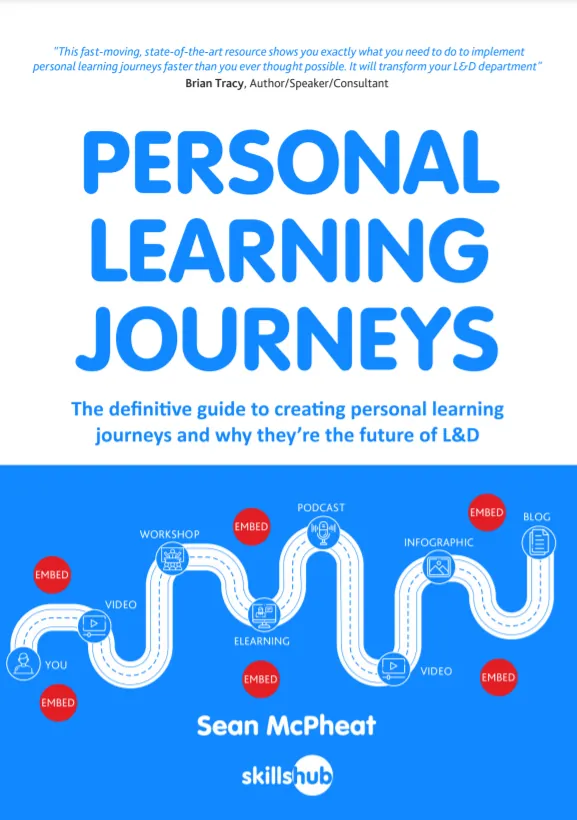
Understanding and tracking the right L&D KPIs is essential for driving impactful learning experiences and achieving business success.
In this blog, we will uncover the 21 most crucial KPIs every organisation should monitor.
As an eLearning company, we know that aligning these KPIs with your strategic objectives can significantly enhance your training programs.
Explore these vital metrics with us and learn how they can transform your approach to learning and development, ensuring your efforts lead to measurable and meaningful outcomes.

Learn How To Create Personal Learning Journeys For FREE!
Essential Learning and Development KPIs for Success
There are many ways to measure success in learning and development, depending on your priorities and objectives.
From quantitative measures like the percentage of students who passed a course for the first time, to more qualitative assessments such as learning satisfaction, you can measure dozens of different metrics.
Here we’ve given you our top 21 KPIs to help you gauge training success:

1. Stakeholder Perception (SP)
Type: Qualitative
This is a subjective measure of the feelings of those indirectly impacted by training, including team leaders, managers, and department heads.
For instance, you might ask, within a questionnaire “how much improvement have you seen in your team, after training?” and offer choices ranging from “no change” through to “significant improvement.”
If training is to recur or an L&D programme is to expand, you’ll need stakeholder engagement, so it’s vital to measure this following each course.

2. Learning Satisfaction (LS)
Type: Qualitative
This is another subjective measure, this time of participant’s assessment of various qualities of the course. These metrics are often captured in post-course anonymised surveys.
You’ll want to ask questions about a range of user experiences including how helpful, easy, interesting, and fun the course was.
These measures (as will all qualitative metrics) can be turned into figures by scoring survey responses. For instance, “excellent” might equal 5 points, “very good” 4 points, etc.

3. Employee Engagement (EE)
Type: Quantitative
Engagement is a little different from performance or satisfaction in that it measures how readily potential participants took part in the training. Did they sign up by the deadline? Did they complete the online course within the recommended time?
It may seem like this is a qualitative measure, since it describes how enthusiastic participants were, but it gets at the truth of this question by measuring actual engagement.
Engagement can be subdivided into metrics such as time for completion, percentage signed up, and other figures you can use to measure participant interest.

4. Business Performance Metrics (BPM)
Type: Quantitative
No, this is not the measure of a music track’s beat, as used by DJs, but a way of assessing an L&D programme in terms of its impact on the business.
How you choose to measure this will depend on the objectives set for the training in advance. For example, a business might decide that it wants to run a sales training course with the aim of increasing conversions by 10% on average per rep.
By this measure, if the business achieved this goal, then the training succeeded.

5. Best Excuses for Non-Attendance (BEFNA)
Type: Qualitative
Okay, this one’s just for fun. But it can be fun for the instructor to share these (anonymised of course) with participants to encourage continued attendance.
For your enjoyment, the best we’ve heard include:
“I had to take my parrot to the vet.”
“I went to the wrong building (twice)”
“We had to hold the secret Santa party that day.”

6. On-Going Sustainability (OGS)
Type: Quantitative
Companies are trying to become more sustainable across the board in the 21st century. Training can help contribute to a business’s sustainability efforts in a range of ways.
You can ask a range of questions which have a yes/no or measurable answer, which makes this a quantitative measure. If you cannot meaningfully measure these things, it is not a helpful metric.
Examples might include: is this course paper-free? Will it result in cost savings and thus reduce wasted energy? Does this course contribute to an understanding of corporate decarbonisation or emissions reduction?
Obviously, courses designed around sustainability must score highly by this measure if they are to prove effective.

7. Job Performance (JP)
Type: Quantitative / Qualitative
This KPI is allied with BPM (see above) but focuses closely on individual courses. It is most suitable for highly specific role-based courses, rather than more general topics.
For instance, you can use this measure well when assessing an IT skills course, but it is not as helpful when teaching something like health and safety.
It can be qualitative (for instance, if a line manager offers their subjective view on the employee’s performance) or quantitative (did the employee improve productivity or reduce errors, and by what percentage?)
You will have a JP score for each participant, and you can aggregate and average these to obtain an AJP (average job performance) indicator.

8. Improved Performance Reviews (IPR)
Type: Qualitative / Quantitative
Like the above measure, you can take a quantitative or qualitative approach to this KPI. This will depend on whether the company’s performance reviews are quantified or not.
Whichever approach you adopt, this metric assesses individual employee outcomes by looking at the end of period assessments they have with their line manager.
This would be a particularly relevant KPI to use if the employee has been put on the training course as an outcome of a performance review. You can then gauge whether this course of action has been successful.

9. Training ROI (TROI)
Type: Quantitative
Here’s one measure that can only be quantitative, since it refers to the financial benefits that an L&D programme delivers to a company.
There’s a specific formula for this one:
TROI percentage = ((monetary benefits – training costs)/training costs) x 100.
For example, if your programme costs £12,000 to run and results in a revenue boost of £15,000, then TROI % =
(15,000 – 12,000)/12,000 x 100 = 25%

10. Retention of New Skills & Knowledge (RNSK)
Type: Quantitative
This is a vital measure because it (hopefully) ensures your courses create a permanent effect on their participants, rather than offering insights they fail to retain.
It must be quantified in some way to be meaningful, and this can be achieved by running a quiz about the main information and skills gained during the course at some specified period after the course ends.
For example, you might run a course in social media marketing, then six months later, ask 20 questions that were answered in the course, and see how many participants can answer correctly.
Don’t expect every participant to retain the same amount of information, however, since everyone learns differently. Also don’t aim for a 100% score, which is unrealistic.
The score will also change over time. An assessment run three months after the course ends will usually produce a higher RNSK score than one undertaken after one year.

11. Training Accessibility (TA)
Type: Qualitative
Although this may be hard to quantify, it is important to assess whether your course is suitable for employees with sensory disabilities or learning impairments (sight, hearing, dyslexia, motor skills, colour-blindness etc.)
This is best assessed by asking relevant participants to subjectively assess, perhaps by means of a questionnaire, their experience.
Again, you can turn this into a quantifiable metric by scoring the questionnaire. Some of the questions you can ask might include:
- Is there a large-print version of course materials?
- Is the training venue wheelchair accessible?
- Does the venue have a hearing loop?
- Are there subtitles for all course video content?
You could set a standard you want to reach with your courses and make sure that at least most of the main disabilities and learning differences are covered.

12. Times Your Patience Is Tested (TYPIS)
Here’s more light relief from all those serious KPIs.
All trainers keep an internal tally of who the troublemakers are within a group, and who tests their patience the most.
Behaviours that might trigger another tally in this category include:
- Persistently turning up after you’ve delivered your topic introduction.
- Refusing to leave a controversial topic alone.
- Objecting to the entire premise of the training topic (“but why should there be a focus on productivity?”)
- Constantly receiving audible text alerts or notifications.
- Being the only participant who ever voices an opinion.
In this respect you can also count TTHSTI (times trainer has swallowed their irritation).

13. Knowledge Acquisition (KnA)
Type: Qualitative / Quantitative
This metric is similar to knowledge retention but is carried out during training to ensure that the relevant core learnings are absorbed by each participant.
With in-person training, this could take the form of an end-of-module recap with the participants answering questions posed by the trainer about what they’ve learnt.
With an online course, it often consists of end-of-lesson quizzes, where the participant must obtain a particular score to progress to the next level. The best designed courses make students revise the subject of any questions they answer incorrectly.
With a quiz, the KPI tends to be quantitative (a pass mark) whereas the in-person summary is a subjective (qualitative) assessment by the trainer that the group is ready to move on.

14. Application of Knowledge (AoK)
Type: Qualitative
A third related KPI in the knowledge retention genre is Application of Knowledge. This means the practical use of a particular piece of information.
While students might retain information, it’s essential to assess whether they know how to apply it in a real work situation. This is particularly important with subjects like conflict resolution, CPR, or safety training.
The best way to assess this is either through observation (the individual’s line manager reports back periodically to the trainer) or through exercises. Fire drills are examples of application of knowledge assessment in action.

15. Behavioural Change (BeC)
Type: Qualitative
Similar to performance reviews, managers can assess behavioural change in participants over the weeks and months after the course is completed.
This subjective KPI is especially important when the course in question is aimed at behavioural change. For instance, if it’s a sales training course aimed at boosting confidence on the phone, does it result in audibly more confident reps making cold calls?
Assessing this involves the line managers or team leaders of participants measuring performance both before and after training and comparing results.

16. Time to Proficiency (TTP)
Type: Quantitative
A common KPI when implementing IT or software training courses, TTP aims to reduce the amount of time it takes new system users to get up to speed. It is also used more generally in measuring onboarding time for new employees.
To assess this, you need a pre-training baseline. How long should it take new employees to be fully onboarded and competent? Does the training allow onboarding schedules to meet that target?
Once you’ve run the course, get managers to measure how long on average it takes users to reach competency. If you fail to achieve the desired outcome, you may need to revise the course design.

17. Training Cost per Employee (TCpE)
Type: Quantitative
There are two ways of interpreting this metric. Firstly, it could refer to the cost to the company for each employee trained.
It could also mean the cost to the training company per student. This will help them assess how much money they need to charge as a minimum per student to be profitable.
This metric should be assessed prior to greenlighting the course. The client company should know how much it is willing to spend per employee and the trainer should be able to calculate how much training will cost as well as what profit margin is acceptable.
This metric helps clarify whether a course offers excellent value for money for both company and training provider.

18. Skill Gap Progress (SGP)
Type: Qualitative / Quantitative
If a company hires a training provider to address a skills shortage, then this is an extremely useful metric to use. It is a measure of how successful the pipeline of skills trained employees is proving.
This KPI can be quantified in terms of employees who have successfully been trained, or who are in progress. It can be compared with an assessment of how many such employees are needed per year or part-year.
A client can also make a qualitative assessment once the training has been running by talking to managers and team leaders. Do they now have enough skilled employees across the relevant disciplines?

19. New Hire Effectiveness (NHE)
Type: Quantitative
Another key onboarding metric is NHE. This measures the aggregated success or failure of new hires once they are trained. A range of questions can be asked about employee performance, churn, and time to proficiency.
This metric is largely qualitative because it requires team leaders and HR managers to assess the success or failure of an onboarding process and then compare it to preset targets.
However, if after instituting new onboarding training, you saw a reduction in employee churn, which could be quantified (e.g. new staff turnover reduces by 20%).

20. Completion Rates (CR)
Type: Quantitative
This is one of the easiest metrics to measure and understand but it too can be interpreted in diverse ways.
It’s simply a measure of how many individuals successfully complete training within a given time. It usually implies that the course was completed to an acceptable standard.
It can also be a measure of the speed of completion. For instance: how many students completed the course within the allotted 96 hours?

21. Glasses of Wine or Beer (GOWB)
Finally, let’s celebrate with another fun one. How many drinks did the trainer need to consume after work to get through their presentations?
For teetotallers, you can substitute fast food or snacks at the end of a long, challenging week.

Maximising Your Training Impact
Using metrics such as those described above fulfils several crucial functions. It ensures training is provided appropriately, efficiently, and economically. It ensures it is fit for purpose and kept into date.
Lastly, it takes into consideration the sometimes differently aligned needs of stakeholders, trainers, and participants.
Here are five ways in which you can increase L&D impact using KPIs:
- Make sure you have a pre-training baseline against which to measure course and/or individual training performance.
- If you don’t have a baseline, make sure you have a concrete and reasonable target – what outcome should the training achieve?
- Decide whether you want quantitative or qualitative KPIs (or a mixture of both).
- Decide whether you need individual or aggregated metrics. Do you need to know the outcome for all individuals, or the average participant outcome?
- Always ensure that metrics are fed back to training providers as well as the stakeholders that commissioned the training, so that the former can adjust course design where appropriate.
Conclusion
KPIs for learning and development can be vital in assessing the success or failure of a training programme. They should be judiciously chosen and applied.
Fortunately, there are numerous metrics to choose from. Both the training provider and the client company should negotiate what benchmarks and methods to use for learning and development assessment before committing.
Skillshub is an eLearning platform offering over 800 off-the-shelf virtual training courses. It also provides a bespoke eLearning service tailored to your precise training needs.
Why not check out our 3000-item eLearning content library today. It’s perfect for integrating with your existing LMS. We’re here to upskill your workforce for the 21st century.













